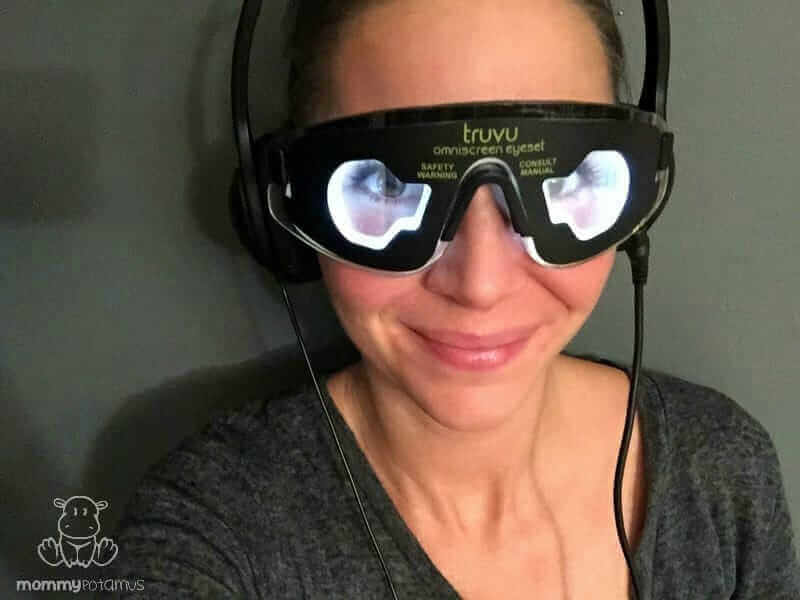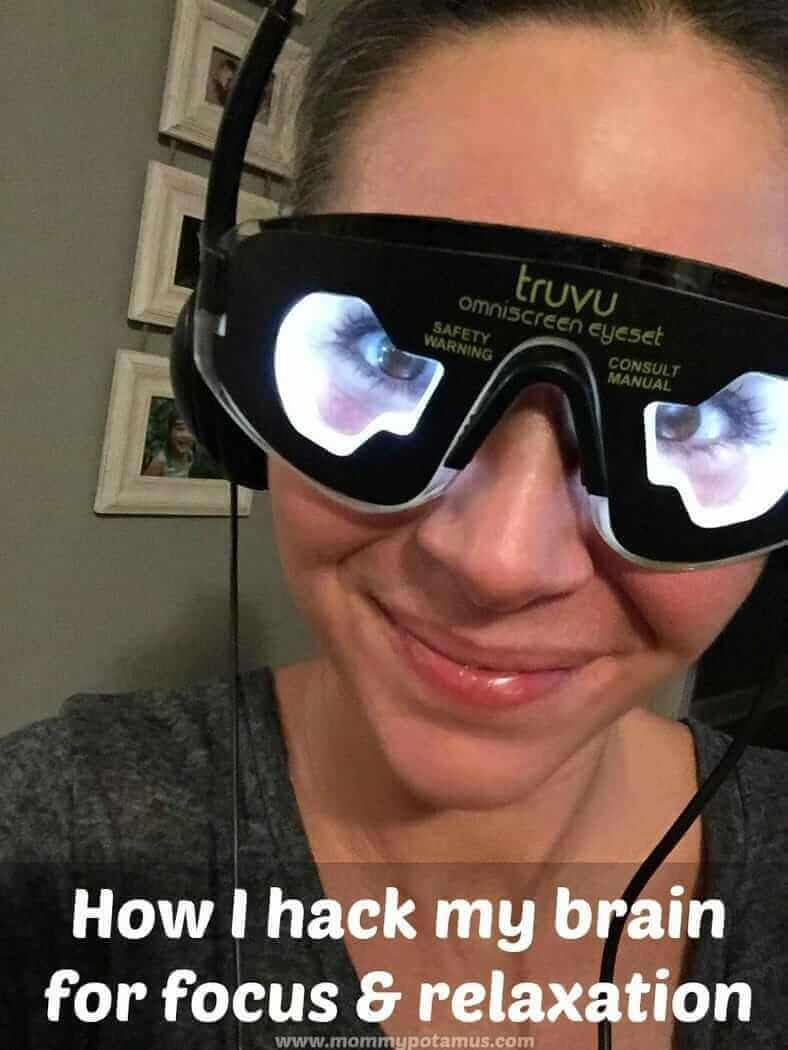
Brain reboot in 3 . . . 2 . . .
That’s the caption I posted with this Instagram photo last week, which showed me using an audio-visual entrainment (AVE) device. I was expecting a few jokes about my awkward fashion choices, but instead there were a lot of requests for more information. Can I just say that I love that you all are as nerdy as I am?
We’ll get to the details soon, but first a little history. My husband has a scar on his forehead from a childhood injury. After the stitches healed the injury was pretty much forgotten until I picked up a popular book on neurophysiology after we were married.
While reading, I realized that certain focus-related challenges he experienced were likely due to a prefrontal cortex injury he’d sustained during that childhood incident.
After researching solutions, we sought the help of a well-respected biofeedback clinic to help his brain “rewire” in a way that would help compensate for the injury. During treatment, one of the complementary therapies that was offered to him was an audio-visual entrainment (AVE) device. They sent it home with him, and I was amazed by how relaxed he seemed after a session.
With his doctors permission, I borrowed the device to help with sleep, and well, I fell in love with it.
What is audio-visual entrainment?
Maybe you’ve heard that your heart rate will naturally sync to a loved ones without you two even speaking a word to each other. Well, our bodies can actually sync up to all kinds of external stimuli (like music), which is awesome until it’s . . . not. Because let’s face it, life sometimes has a way of derailing even our best efforts to concentrate, keep a positive attitude, and slow down/relax at the day’s end.
I’ve personally struggled a lot with this at times, especially when my experience as a parent triggers a painful memory from childhood. (My dad died when I was eleven, and as amazing as my mom was at helping me process the loss I still come across forgotten scars every once in awhile.)
It’s not just old memories, though. Sometimes I feel myself slipping into negative thought patterns on days when nothing goes according to plan. It’s like I’m a bowling ball that’s fallen into the gutter and can’t heave herself back onto the lane.
For me, AVE technology is like a manual override button. It helps me get back into the lane I want to be in.
Also called brainwave entrainment, it uses light and sound to guide the mind toward alpha waves (for relaxation), beta waves (for energy and focus), theta waves (for creativity), or delta waves (for sleep). The particular device I use even has a setting for promoting mental flexibility when you feel stuck – something that happens to me often when I’m learning something new.

Brain-Entrainment = A meditation shortcut?
In The Adrenal Reset Diet, Dr. Alan Christianson recommends meditation as part of the healing process, then suggests AVE as an alternative for those who find meditation difficult. That’s probably because – according to EEG readings – the two approaches produce similar effects.
Personally, I’m fascinated by the benefits associated with meditation. Take for example this small but well-designed Harvard study, where MRI scans revealed that meditation “increased concentrations of gray matter (the ‘computing’ or processing neurons) in several brain areas, including the hippocampus (a deep brain structure important for learning, memory, and the regulation of emotions) and other regions associated with remembering the past and imagining the future, as well as with introspection, empathy, and the ability to acknowledge the viewpoints of others. ” (source, emphasis mine)
Also, according to Web MD:
“Most Americans aren’t raised to sit and say ‘Om.’ But meditation has gained millions of converts, helping them ease chronic pain, anxiety, stress, improve heart health, boost mood and immunity, and resolve pregnancy problems.
Any condition that’s caused or worsened by stress can be alleviated through meditation, says cardiologist Herbert Benson, MD, well known for three decades of research into the health effects of meditation. He is the founder of the Mind/Body Institute at Harvard Medical School’s Beth Israel Deaconess Medical Center.
‘The relaxation response [from meditation] helps decrease metabolism, lowers blood pressure, and improves heart rate, breathing, and brain waves,’ Benson says. Tension and tightness seep from muscles as the body receives a quiet message to relax.”
The article goes on to say that meditation is relatively easy to learn, which is probably true for a lot of people. Personally, that has not been my experience, which is why last year I finally bought a David Delight Plus from Mind Alive. It was an investment for sure, but I use it almost every day along with the other things I mentioned in this post about loving our adrenals – and it has made a huge difference for me.
Can audio-visual entrainment be used with kids?
In many cases, yes. The device I have is often used to support focus, attention, and learning in school-aged children.
Why the DAVID Delight?
Here are a few reasons:
- It’s the same device that the biofeedback clinic used as a complementary therapy for my husband, so I already had experience with it.
- In The Adrenal Reset Diet, Dr. Alan Christianson recommended it and just one other device, the Proteus Plus.
- It’s wired so it doesn’t rely on Bluetooth or other wireless technologies (Here’s why I minimize my use)
- It’s received positive feedback in several clinical studies, including this one and this one.
The model I use comes with five basic categories – Energize, Meditate Brain Booster, Sleep and Felling Better – and five session options for each category. One thing I wish I had known before ordering is that for $20 I could have upgraded to clear glasses. They work just as well as the opaque glasses if you want to lay down and close your eyes for a session, but the benefit is that you can also use them while reading. I did eventually upgrade, but I wish I’d had them all along. You can find the David Delight Plus with clear glasses here (the photo shows the basic stock photo with the opaque glasses but the listing describes the clear ones), and the other setup with opaque glasses here.
The less expensive David Delight– which features two session options for each of the main categories – also comes with an option to upgrade to the clear glasses (again, the stock photo shows the opaque glasses but the listing describes the clear ones.)
So . . . is it worth it?
I use my DAVID Delight Plus almost everyday, and it has made a huge difference in helping me reset after stressful events, find my creative flow, and even sometimes sleep. So for me, the answer is yes. The level of relaxation I feel after a session is very similar to how I feel after a good massage, which is totally worth the $1/day it cost me to use in the first year. (The real cost per day is actually much lower when you divide the total cost by many years, which is typically how long they last.)
That said, I hadn’t planned on writing about it because it is an investment, and there are certainly other ways to “reboot” – I’ll be covering some in future posts. This is simply one of my favorites because it doesn’t require any skill on my part to experience the benefits.
Alrighty, I think that about covers it for now. I hope this post answered some of your questions – if you have more please leave them in the comment below!




